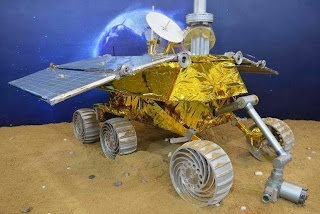Like many who became enamored with space, I grew up with a healthy dose of "Star Trek". I was too young to remember when it premiered, but I do remember seeing the final few episodes on NBC in 1969. They re-ran it for a season or two in syndication, but it was gone from the airwaves in Jacksonville by 1971. It returned to the air on WJKS-TV, channel 17, in early 1974, at 5 P.M., and immediately I began watching it. As a starry eyed youth with dreams of space, "Star Trek" was the perfect show. Not only did it give me spaceships; it gave me a daily morality play as well as good stories. I was hooked.
It was that way for the next year and a half, until "Space:1999" premiered. For the first few episodes of this new show, I was convinced that my "Star Trek" days were behind me. A few episodes later, I began to have my doubts. While the designs from "Space:1999" were in many ways better, the stories were a bit too philosophical and a touch slow.
It was in late 1975 that I met a fellow Trekkie named Greg Staylor. (I am probably misspelling the last name). He lived nearby, and was one of the few people I knew who had picked up copies of those most desired items; the blueprints to the "Enterprise", and the "Starfleet Technical Manual". Both came from the mind of Franz Joseph Schnaubelt (or as we knew him, Franz Joseph).
My recently turned thirteen year old mind was amazed. Greg let me look through that manual for hours once, and I couldn't put it down.
Over the next few weeks, my mind was abuzz with my own Starfleet designs. Most of them were support craft, cargo carriers, tugs, exploration vessels, etc. But one would stick out.
The U.S.S. Los Angeles.
I recall naming it after the US Navy dirigible, and pictured a small class named likewise. This would only have been like four ships, the Los Angeles, the Shenandoah, the Akron, and the Macon. By the time of "Star Trek," the original series, it was the sole survivor.
Because I knew it was old, akin to the legendary DY-100/Botany Bay class vessels, I decided to borrow from vessels that looked late 20th-early 21st century. It had a primary hull that was spherical, maybe 37 meters (121 feet) in diameter. Length was around 243 meters (800 feet). That basic design borrowed heavily from the "Discovery" from "2001: A Space Odyssey", as well as the designs built by Martin Bower for "Space:1999".
What separated it from those designs were the two warp nacelles.
I did a profile drawing of the ship, along with a full description and history, on a notepad that I did all the starships in.
When my eighth grade school year began, I brought in the notepad to show my art teacher, Mrs. Sullivan. She was very impressed, and encouraged me to do more.
As the school day was ending, a fellow student named Steve came up behind me, knocked the pad out of my hands, and took off with it. Days of pleading, even giving him a bribe of $5, never saw the notepad returned.
It was simply gone.
But I never forgot that design.
Recently, I had the design come to mind while finishing up a story that involved my thirteen year old alter ego in 1976. After all these years, I never forgot that ship.
Today, I decided to resurrect it.
This is just a quick sketch, really. It captures the design well. What's different is that my skill as an artist has improved.
So, what has changed about the ship?
The Los Angeles is not an official Starfleet vessel, so it is not "U.S.S.". It is operated by a civilian crew and spends most of its time near the major Solar System based naval yards. It is based out of Utopia Planitia Yards, Mars. The design allows for easy removal of the warp nacelles (in this case, labelled "TEST", with yellow and black diagonal bands on their sides). Most of the time, it operates using impulse power. When it does do warp drive testing, it normally travels no further than a few light years out. The forward nacelle mounts can slide in tracks down the length of the spine of the ship, allowing for various lengths to be tested. As per my original story, not only is it very old, it is also the sole survivor of its class.
It felt good to bring this design back to life. For a couple of hours today, I was that thirteen year old again, huddled over my dining room table, carefully designing one of my first starships.









